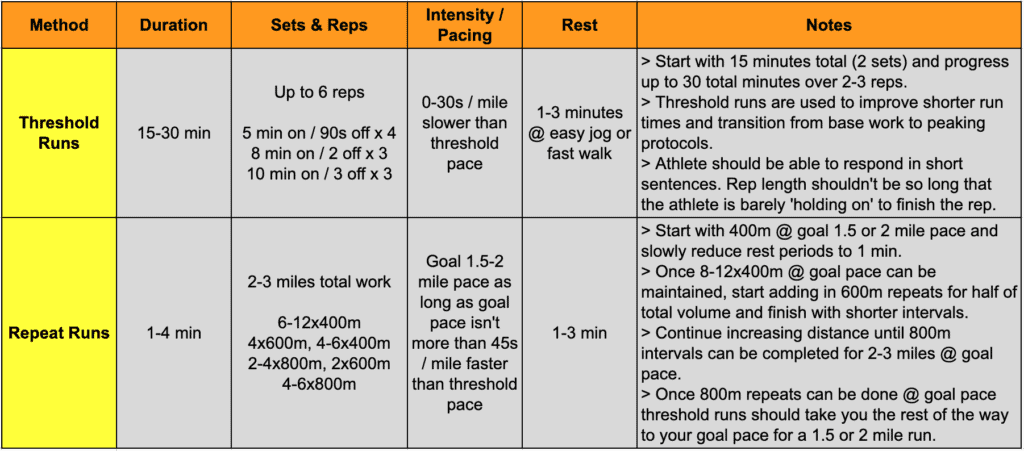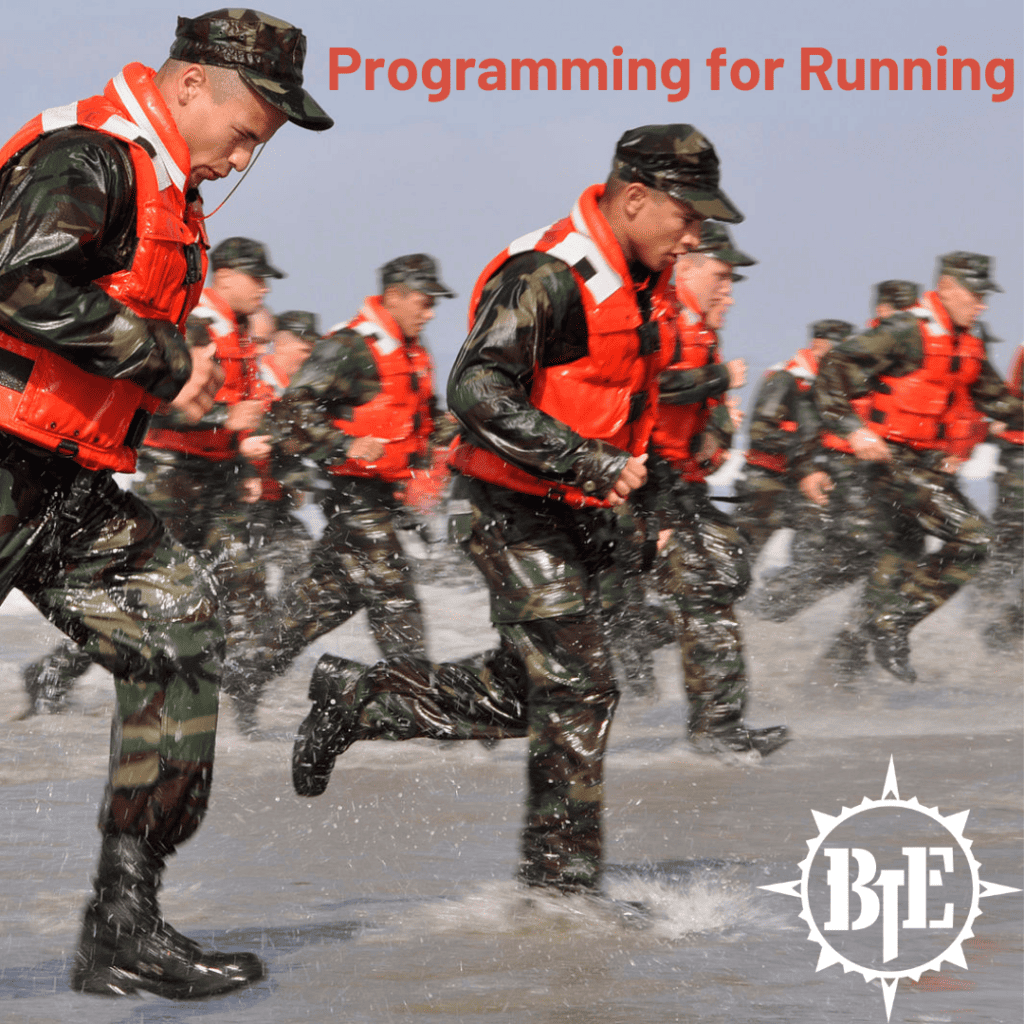Running fast requires two primary things: 1) Good running technique and 2) a strong foundation of aerobic fitness. If you’re missing either, you won’t be able to run a fast time on your PT test. The deeper into your selection course you go or the longer you have to run, the more weakness in either will be exposed. Thus, intelligent running programming for special operations selection training is crucial.
Running and Fitness
Unless you are a highly skilled runner who has built a strong foundation of running fitness over multiple years, your running efficiency likely isn’t high enough to develop aerobic fitness via running.
In other words, running reveals your fitness more than it develops it. Until you’ve reached a certain threshold in your development, it’s more effective to train for running than it is to run as a form of training.
That’s not to say that you can’t improve your fitness via running – you certainly can. However, running is best thought of as a way of enhancing the output of an existing aerobic foundation, not building one.
In most selection courses, you have about one or two timed runs per week, at most. And, the required run times are equivalent to a mediocre pace for a high school cross country runner. In other words, the standards aren’t high relative to what a dedicated runner can do in isolation.
It’s not running a 9-minute 1.5-mile run that’s terribly hard, it’s doing it in the context of a SOF selection course alongside countless other demands. This is where the challenge lies in training for selection.
For this reason, when programming running, we use pacing instead of heart rate zones to dictate training intensity. When programming, we think of running as a distinct skill to develop outside of our energy system work.
Running efficiency
Preventable soft tissue injuries are one of the primary reasons for failure in special operations selection courses. So, efficient running is as important as fast running. This requires a high level of motor skill.
Outside of timed runs, you’ll spend a lot of time on your feet in selection running from event to event, to the chow hall, to the barracks, and everywhere else. You need to be efficient to cover all that ground without breaking down.
We place as much emphasis on technique as speed, knowing that the two will go hand-in-hand over time. It’s important to note that when changing your running technique you’ll often see an initial drop in performance (this is an opportunity to apply the concept of investing in loss). This occurs because you are loading tissues in new ways and building new motor patterns, and your fitness will take some time to catch up. When it does, your run times will speed up and your aches and pains will decrease.
In summary, efficient running is fast and safe running.
Running cues:
- Relax your back – Think of dropping your ribs to your belt buckle.
- Push the world behind you – Don’t reach with each stride, focus on short and quick strides with your foot landing underneath you.
- Rotate your trunk – Your sternum should move from 11 to 1 oclock. Think of driving your elbow behind you to drive this motion (don’t reach forward). Your elbows should drive forward and backward (no rotation) as though on rails.
- Relax your head – Think of tilting your chin up and keeping your gaze straight ahead while your head floats over your shoulders.
Running Methods
In normal circumstances, we program 2-3 running workouts per week depending on the training phase, selection course, and individual’s fitness level.
Running methods are broken into three categories: foundation, speed, and support work. Both foundation and speed will always be present in your program.
Support work is the bridge between foundation and speed work and is utilized once a foundation has been established to help translate the foundation you’ve built into faster run times.
Before we discuss these methods you need to do an assessment to use as a baseline to determine running pacing for each method.
Assessment:
If you’ve been running consistently and can easily run for 30 minutes, you’ll do the following test.
We have athletes perform the following test on a day when they are well-rested:
- Warm up with a 10-15 minute jog that includes at least five 15-20 second sprints.
- After the warm-up is complete, rest for 4-5 minutes before beginning the test.
- On a relatively flat surface, run at the absolute fastest speed you can possibly maintain for 30 minutes.
- You should be using a GPS device (phone or watch) or running at a track where you can easily measure total distance over the 30-minute trial.
At the end of this test you should have your average pace over the 30 minute trial (time per mile). This is your threshold pace.
You’ll use this pace to assign running paces for all the methods described below.
Foundation work:
The most common mistake that most trainees make with their running is always running as fast as possible on each run. This can work well for a while to build fitness if you haven’t been running. But, you’ll often plateau quickly without other developmental work.
The purpose of foundation work (long runs) is to improve efficiency and drive aerobic adaptations. By slowing down and focusing on technique you’ll be able to improve efficiency and drive aerobic adaptations while recovering more efficiently compared to running as fast as you can on each run. These runs are essential for improving your run times at every distance. Also recall from earlier that we work to drive a lot of systemic aerobic adaptations with training methods other than running, so volume here doesn’t have to be terribly high.
Foundation runs can be broken up as much as is needed to protect quality during initial training blocks. If you find running technique, breathing patterns, or your heart rate gets out of control during distance runs, it’s ok to add in short rests throughout the workout until you’ve reached the prescribed volume.
For example, you’re better off doing 6 reps of 5-minute blocks with a one minute rest between sets than grinding through 30 minutes with poor technique. Over time you’ll be able to lengthen these blocks while maintaining quality.
You need to be careful when adding volume to your long runs. Stick to around a 10-20% increase per week until you are up the longest run you’ll need to do in selection (usually 5 miles).
If you have taken a long break from running, start with 10-15 minutes total on your long run (broken up as needed) and build from there. That may seem like a small start, but you’ll be able to make progress much faster by incrementally building on success.
Once you can easily do your distance runs without stopping, adding in surges (also known as fartleks) will help add speed to your runs and get you used to dealing with more variable terrain. These runs also help teach you how to modulate your stress response when forced to mix in periodic ‘sprints’ during long and non-stop activity. Physiologically, these sprints target fast-twitch muscles that aren’t normally used at slower speeds or until deep fatigue sets in.
Pickups, where you finish the long run at a faster pace, can also be added in after distance runs can easily be executed. These are a great way to develop mental skills by pushing yourself to finish strong despite exhaustion. They also help build confidence that you have a deep reservoir of fitness available, even when fatigued.

Speed work:
Sprints, or speed work, are an important part of your running programming. They serve multiple purposes:
- They help improve running technique and neurological efficiency .
- They help make you more resistant to injury by preparing tissues for high intensity activities.
- From an energy system perspective, sprints drive adaptations in the aerobic properties of fast-twitch fibers, the speed at which your body can metabolize oxygen, and the rate of maximal ATP utilization via the ATP-PCr system.
- Practically speaking, they are a part of pretty much any selection process, and being able to do them without injury is extremely important.
Sprints can be included in every phase of training, from building an aerobic foundation to peaking for selection. In later blocks, where you might have a threshold and repeat run day in your training process, you can integrate sprints into your distance runs or as part of repeat days.

Support / pacing work:
Support or pacing work is the bridge between long-distance and speed work. To bridge the gap effectively requires a relatively well developed aerobic foundation. If you can already hit your long run times (3-5 mile run) or are close (within 30s / mile) to the desired pace, the repeat method described below can be implemented immediately.
If you haven’t been running those distances consistently or can’t stay within 30s / mile of your required pacing, you should stick with two foundation runs per week until reaching the required pacing with your long runs.
Repeats are an extremely effective method of slowly working up to your desired 1.5-2 mile time through slow increases in the distance of each repeat at a set pace. For example, you’ll want to start with mostly 400m repeats at your desired pace and slowly work up to 800m repeats at the same pace.
Once you can complete a full workout of 800m repeats you can start adding in threshold runs. This will be the final step to reaching your desired 1.5-2 mile run times. If you find your pacing on threshold runs feels easy, you can slowly increase pacing (faster than threshold). This is common when running consistently with an intelligent plan for the first time.

Wrap Up
Running is just one of the many capabilities you must possess if you want to pass your SOF selection. In our book, Building the Elite, we cover this topic in more depth, and how to fit running into the larger process of preparation for a selection.




Hey guys fantastic article, just a quick question, you mention using pace as an intensity guide for programming runs but for foundational runs training the aerobic base (zone 2 stuff), would hr not be preferable to pacing due to other factors such as heat/ terrain, stress etc ?
Also would zone 2 hr rucking cover aerobic base entirely or would you need to program specific running low hr stuff
Slowing down your pace from your threshold pace (as described) will put you in the ‘aerobic’ zone. It’s unlikely to be zone 2 (more like zone 3/4), but is still slow enough to help improve aerobic fitness. Also, the volume is low enough that it’s still a more effective method of improving running despite the increase cost of recovery.
Rucking and swimming (assuming you’re doing 2-3 days per week) should be enough to develop your aerobic base so you don’t need to do zone 2 runs.
Hello,
I have few questions about support/ pacing work.
Could you use both threshold and repeat runs in same 3-6weeks long training block or should they be in different blocks?
Is there a place for support/ pacing work in aerobic foundation block? where would they fit the best?
I have your book and im trying to understand more how to implement running into block periodization.
Thank you
Johannes
Yes, threshold and repeat runs can be in the same block. We often do this over the final 6-10 weeks before an athlete needs to ‘peak’ for an event, selection, etc.
You can also have pacing work mixed in when building and aerobic foundation. But, it needs to be done outside of your other low intensity work like rucking, swimming, or other no-impact training sessions. We will have the athlete do one or two of these workouts per week until the athlete can easily do the longest distance required for whatever they are training for. At that point, we still keep one of those sessions in the program, but also add in repeats and eventually threshold workouts.
Just trying to clarify my running progression.
Once I accomplish my prescribed volume in my foundation runs (2 times per week) and I am ready to implement the repeat runs, do you want me to replace one foundation run with the repeat (maintaining 2 runs)? Or instead keep 2 foundation runs and add the repeat run as my third day of running per week? Then progress the repeat day into the threshold run.
I have been completing my sprint work prior to one of the foundation runs each week, HICT twice a week, and sled drags on a paved surface 1-2 times a week for a distance of .5 – 1 mile each session. That’s a total of 5 conditioning workouts a week with varying intensities.
Always keep one foundation run in your program even as you add threshold and repeats to your program. Keeping a foundation run in your training will maintain your ability to run longer distances at the desired pace.
Eventually, you want to move to more volume in task-specific training – less HICT, more running and rucking. So, as you add more running sessions you’ll phase out your HICT workouts or drop them to lower volumes to allow you to recover and adapt to the increased running volume. The sprints can be thought of as an ‘add on’ to finish up the foundation run and aren’t a separate workout. Your sprint volume should be low enough to not beat you up but keeping a few in there will help you maintain your top end speed and running mechanics.
Hi, i’m from France, i wait that your Book become available in papier version in september…
I have a question on foundation run, i did the test with 5min/km, and i must run at 5min30/km, it’s really hard and my Heart rate go to 180 with a max at 195, it’s normal?
For the 30-minute threshold test that’s normal, especially if you’re young (late teens or 20s).
Hi, the foundation runs pace equal marathon Pace? My Heart rate during these basic runs Always goes UP with 170 bpm for a max at 200…
Our reference is to go 30 to 60 seconds slower than your per-mile threshold pace. So, that may work out to your marathon pace, or pretty close to it. Depends on how good you are at marathons or running that kind of distance. Main thing is for it to feel pretty easy. You should be at least close to being able to breathe through your nose or talk during the run.
Hi, the foundation runs pace equal marathon Pace? My Heart rate during these basic runs Always goes UP with 170 bpm for a max at 200…
hi, it’s a 20 minutes test to find lt2 and work under that theshold to increase aerobic capacity, what’s your 30min test? thanks
Regarding running outside of normal aerobic capacity work, when would you put the runs into the overall plan? If aerobic capacity and work capacity are taking up a large percentage of the training volume, when would you place the long run within the week?
We typically program 2-3 days of aerobic capacity (a mix of runs, rucks, & swimming), depending on the individual and what they are training for. That leaves several days open for repeats, threshold, and/or sprint work (or any other conditioning method we utilize), or strength work. Work capacity sessions are predominately upper body focused and can be done on the same day as any strength, running, or aerobic capacity workout – typically programmed as a second workout for the day (am/pm sessions).